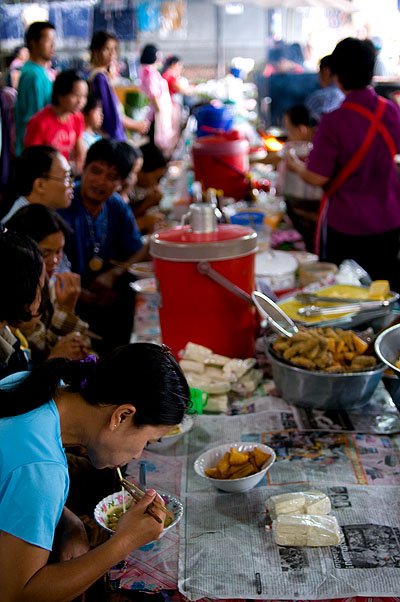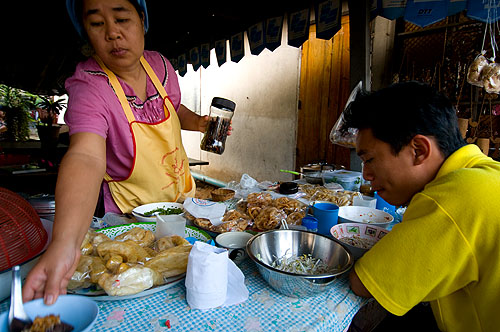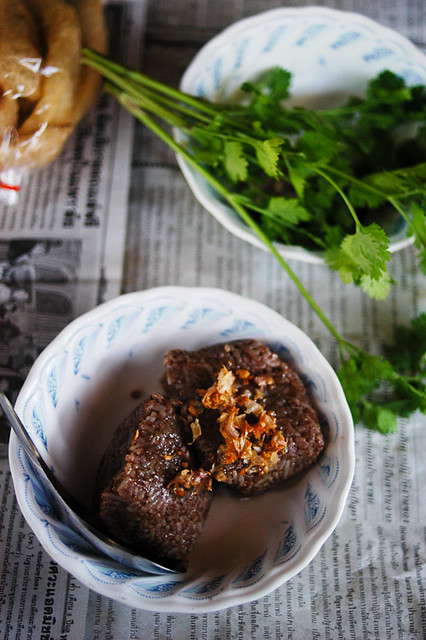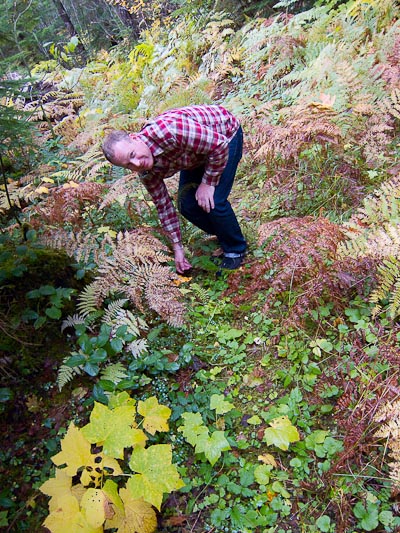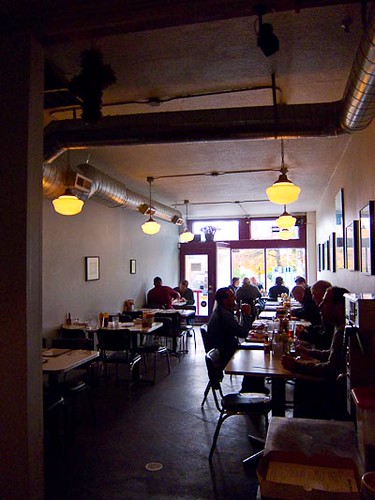Khao sen and...
 The quintessential Mae Hong Son dish - or perhaps simply the most popular dish in Mae Hong Son - is a bowl of khao sen. Literally ‘rice threads,’ it’s the local name for a dish combining the thin rice noodles known elsewhere in Thailand as khanom jeen and a thin, pork- and tomato-based broth -- a dish known in northern Thailand as khanom jeen nam ngiaw.
The quintessential Mae Hong Son dish - or perhaps simply the most popular dish in Mae Hong Son - is a bowl of khao sen. Literally ‘rice threads,’ it’s the local name for a dish combining the thin rice noodles known elsewhere in Thailand as khanom jeen and a thin, pork- and tomato-based broth -- a dish known in northern Thailand as khanom jeen nam ngiaw.
Sold alternatively early in the morning and late in the afternoon, khao sen is regarded as more of a snack than a meal. Vendors who sell the dish always tend to sell it with one other snack-like item such as khang pong, a type of local deep-fried vegetable fritter; deep-fried pork rinds or buffalo skin; or khao kan jin, rice and pork blood steamed in a banana leaf package.
I’ve touched on all of these dishes previously, but I suppose it wasn’t until this visit that I understood just how much the people in Mae Hong Son love them. Khao sen is pretty much the go-to snack here, and there are several places to get it in town, so I thought I’d try to corroborate the vendors I’m familiar with all in one post.
If you’re looking for a khao sen breakfast, you’ll have to go to Talaat Say Yut, Mae Hong Son’s morning market. There, three vendors sell the dish at the northern edge of the market:
View Thai Eats in a larger map
My personal favourite bowl, and my breakfast at least three or four days a week when I’m here, is served by the two ladies who also do a delicious shallot-based khang pong. In the Thai Yai style, the broth is thin, with only bits of meat, and the dish is topped with deep-fried crispy noodles, garlic oil and some coriander leaves. The vendor across from them, Yay Jang, sells a similar bowl plus a few banana leaf packages of khao kan jin.
During the day, the options are limited to one vendor at the Chao Pho Kho Mue Lek Shrine:
View Thai Eats in a larger map
The khao sen here includes chunks of blood (normal for the northern-style khanom jeen nam ngiaw, but unusual for the local style) and is served with a somewhat oily papaya-based khang pong (both pictured at the top of this post).
Mid-afternoon is, in my opinion, the best time for khao sen. A pair of friendly vendors operating from a rickety stall along Th Khunlumpraphas serve the dish with my favourite khao kan jin:
View Thai Eats in a larger map
The meaty rice is drizzled with garlic oil and served with sprigs of fresh coriander or, if they can get it, a type of aromatic root. The khao sen is also good, and is served with optional sides of deep-fried pork rind.
Around the corner, Yay Jang, the same vendor who serves the dish at the morning market, does the same two dishes, with a ‘raw’ version of khao kan jin, in which, I assume, raw blood is mixed with cooked rice:
View Thai Eats in a larger map
This one’s popular, and you can expect a line here.
Pho Phieng Phochana
 Despite being a northern dish, and despite there being at least six places in Mae Hong Son that serve it, there’s little khao soi here worth recommending. Even one longstanding restaurant that specializes in the dish turns out bland, soulless bowls.
Despite being a northern dish, and despite there being at least six places in Mae Hong Son that serve it, there’s little khao soi here worth recommending. Even one longstanding restaurant that specializes in the dish turns out bland, soulless bowls.
Pho Phiang Phochana, a homebound restaurant near Mae Hong Son’s airport, serves just about everything, including bowls of self-proclaimed ‘Chiang Mai khao soi.’ It was the sign advertising this fact that caught my attention, and that also got me to thinking about the dish. I used to think of khao soi as a northern dish – I’ve probably eaten it in nearly every province in northern Thailand. But if I’m being honest, it’s never really very good outside of Chiang Mai. And if I’m being extremely honest, even in Chiang Mai there are only maybe two places where I care to eat it.
But back to Pho Phiang Phochana. Of the bowls I’ve had in Mae Hong Son, I reckon they do the best one. The broth was just rich and spicy enough, and the sides were of good quality. My only real complaint would be that they overdid it on the crispy noodle topping, making it somewhat hard to get to the main event.
If you’re going to eat khao outside of Chiang Mai, you may as well do it here.
Pho Phiang Phochana Th Niwet Phisan, Mae Hong Son Open 10am-8pm
View Thai Eats in a larger map
How to make: A Thai-Yai meal you can make just about anywhere
 I find the food up here in Mae Hong Son fascinating and love making and sharing local recipes. Unfortunately, many of the dishes call for obscure ingredients that aren’t generally available outside of Mae Hong Son or Myanmar’s Shan State.
I find the food up here in Mae Hong Son fascinating and love making and sharing local recipes. Unfortunately, many of the dishes call for obscure ingredients that aren’t generally available outside of Mae Hong Son or Myanmar’s Shan State.
With this in mind, I asked my neighbour, Phi Laa, a native of Mae Hong Son, to share some recipes I thought one could make just about anywhere. I’ve made no concessions to the following recipes, and assuming you have access to a basic Asian supermarket for some fresh herbs (lemongrass, Kaffir lime leaves, etc.), the most obscure ingredients you’ll need are shrimp paste, dried turmeric powder and sesame oil.
The first recipe is a simple but delicious salad, known locally as saa, of green tomatoes. Nuea tam, ‘pounded meat,’ is an deceptively simple side dish that’s meaty, salty and spicy. And finally, oop is the local word for a type of curry, the chicken version being arguably one of the most famous local dishes in Mae Hong Son. There are several variations on oop, some using different protein such as hard-boiled eggs or pork, with others based around vegetables such as eggplant, potatoes (oop aloo, from the Hindi word for potato) or ferns. The recipes for the various vegetable-based oop are nearly identical to the below, but don’t have lemongrass or lime leaves, and often include slices of pork belly.
Phi Laa was working too fast for me to record the exact amounts of the various ingredients, so I’ve done my best to provide my own estimates retroactively. But like any Thai cooking, you should taste often and rely on flavour (and experience), not amounts.
Saa Makhuea Som (Thai Yai-Style Tomato Salad)
Green and/or slightly unripe tomatoes, 5, seeded and sliced thinly Shallots, 5, sliced thinly Fresh chili, 4 (or to taste), chopped Cilantro and green onion, one stalk each, chopped Roasted peanuts, about ¼ cup, ground Salt, to taste Sesame oil*, to taste
Combine tomatoes, shallots, chili, herbs and peanuts. Season to taste with salt and oil.
Serve alone, as a snack, or with rice.
*The sesame oil in Mae Hong Son is made from unroasted black sesame seeds. It’s very different in flavour and appearance to the more ubiquitous Chinese-style roasted sesame oil. If you’re striving for authenticity, I’d suggest mixing 1 part Chinese sesame oil with 3 parts of some neutral-tasting cooking oil.
Nuea Tam (‘Pounded Meat’)
Coarse cut of beef, about ½ kilo, cut into chunks about the length of your pinky finger Turmeric, about ½ tsp Salt, 1 Tbsp Ginger, 1 piece about 4cm long, peeled and chopped Garlic, about 5 cloves, chopped Cooking oil, about ¼ cup Dried chili powder, to taste Salt
Put beef in a saucepan and cover with water. Add turmeric and salt. Bring to the boil, reduce heat slightly and simmer over medium heat, uncovered, until the water is completely evaporated and beef is tender.
After the beef is cool, pound the pieces in a mortar and pestle until flat:
By hand or using scissors, pull the threads of beef apart as thinly and finely as possible.
Pound ginger and garlic in a mortar and pestle until you have a coarse paste.
Heat oil in a wok. Add ginger and garlic mixture and fry briefly until fragrant. Add beef and fry over medium-high heat, stirring constantly to prevent from sticking as much as possible (inevitably, some of the beef will stick to the wok, which is OK and provides the dish with its desired dry texture and smokey flavour):
Add dried chili and season to taste with salt. Continue to cook until beef is dry and stringy.
Serve with rice.
Oop Kai (Thai Yai-Style Chicken Curry)
Curry Paste Salt, 1 tsp Small dried chilies, six (or to taste) Shrimp paste, 1 Tbsp Garlic, 3 cloves, chopped Shallots, 4, chopped Lemongrass, 2 stalks, sliced Tomatoes, 2, seeded Turmeric, about 1 tsp Masala*, about 2 tsp Kaffir lime leaves, 5
Chicken, 2 legs, jointed Cooking oil, about ¼ cup
Pound salt, shrimp paste and dried chilies in a mortar and pestle until you have a fine paste. Add garlic, shallots and lemongrass and pound until you have a coarse paste. Add turmeric, masala and tomatoes and grind until well-combined. Add Kaffir lime leaves and bruise:
In a wok, combine curry paste, chicken and cooking oil and enough water to nearly cover the chicken:
Cover, bring to a light boil and simmer over med-high heat.** When chicken is somewhat done and the oil has risen to the top, after about about 10 minutes or so, remove lid, increase heat and allow to simmer, uncovered:
until most of water is evaporated.
The resulting curry should be rich, fragrantly herbal and oily.
Serve with rice
*This is a local spice mix similar to Indian Garam masala, which can be used as a substitute. **I was genuinely surprised and somewhat skeptical about this cooking technique – most Thai cooks would fry the curry paste in oil first to allow it to amalgamate and release its oils and flavours – but it worked very well.
Lung Roen
 Unfortunately Laap Phrae’s time in my personal restaurant limelight didn’t last very long. Only a couple days after eating there, I decided to hit up an open-air laap place at the outskirts of town.
Unfortunately Laap Phrae’s time in my personal restaurant limelight didn’t last very long. Only a couple days after eating there, I decided to hit up an open-air laap place at the outskirts of town.
I now have a new favourite laap restaurant in Mae Hong Son.
Lung Roeng does northern-style laap just as I like it: finely minced, relatively dry, lots of dried spice flavour and spicy.
They also serve grilled dishes, meat-based soups and som tam. In addition to beef laap (shown above), I also ordered tam som oh, a classic northern Thai dish combines pomelo, a black paste made from field crabs, slices of lemongrass and eggplant.
If this alone isn’t reason enough to make the trip, across the street is a woman selling the spectrum of local Thai Yai-style deep-fried snacks:
Including khang pong (strips of green papaya battered and deep-fried), thua phoo thawt (deep-fried tofu), and thua phoo lueang thawt (chickpea flour fritters).
Lung Roen Off Th Pracha Seksan, Mae Hong Son 085 723 991 10am-6pm Mon-Sat
View Thai Eats in a larger map
Canon PowerShot S90
 Mae Hong Son, shot with the Canon PowerShot S90 (ISO 250, f/4.9)
Mae Hong Son, shot with the Canon PowerShot S90 (ISO 250, f/4.9)
In response to my own post of several months ago, I eventually settled on the Canon PowerShot S90.
I've generally been pretty happy with it, and it's liberating to be able to stuff a camera in my pocket rather than lug around an entire kit. A few other positives:
-Easy to manipulate f/stop and exposure -Has a 'fast' f/2 aperture at the wide end -Can shoot in RAW -As shown above, with lots of light and at low ISOs, I can get pretty good quality shots
Some failings:
-Flimsy construction, particularly the wheel that controls the previously-mentioned exposure -Shots generally tend to look 'flat' with little dynamic range -Pretty noisy, even when shooting in RAW at relatively low (400) ISOs:
 Mae Hong Son's Wat Phra That Doi Kong Muu, shot with the Canon PowerShot S90 (ISO 400, f/2.0)
Mae Hong Son's Wat Phra That Doi Kong Muu, shot with the Canon PowerShot S90 (ISO 400, f/2.0)
As always happens, I wish I'd held out a few months and bought the S95. I played with it in a store recently and the build is a lot stronger, although the image quality appears to be the same.
Panelle alla Mae Hong Son
 As mentioned previously, people in northern Thailand love their deep-fried food. And in a weird twist of fate, one kind of deep-fried snack that’s particularly popular in Mae Hong Son is also associated with the streets of Sicily.
As mentioned previously, people in northern Thailand love their deep-fried food. And in a weird twist of fate, one kind of deep-fried snack that’s particularly popular in Mae Hong Son is also associated with the streets of Sicily.
Known there as panelle, in Mae Hong Son they’re sometimes called tao huu thawt, literally ‘fried tofu.’ This is a misleading name, as the crispy deep-fried snacks are actually made from chickpea (garbanzo bean) flour.
An obscure ingredient that I’ve only ever encountered here in Mae Hong Son or in Indian groceries (where it’s known as besan), chickpea flour is also popular in Myanmar, particularly among the Shan, the same Tai ethno-linguistic group that inhabit Mae Hong Son, who use it to make something the Burmese call Shan tophu kyaw, ‘deep-fried Shan tofu,’ a dish that outsiders sometimes call Burmese tofu.
The vendors in Mae Hong Son’s morning market sell a variety of dishes using chickpea flour. In one, known as thua oon, ‘warm beans,’ the flour is boiled with water, and the thick, yellow, gelatinous liquid is served over noodles. In another version, the flour and water mixture are allowed to set until firm enough to cut into slices which are eaten in the form a spicy salad.
But the tastiest and seemingly most popular version is thua phu thawt, ie the panelle of Mae Hong Son, where the firm mixture is deep-fried. They’re light and rarely oily, and when hot, actually taste a lot like McDonald’s French fries. In Sicily they’re fried in wide, flat sheets and are apparently served in sandwiches. In Mae Hong Son’s morning market, they’re served as tiny triangles and come with a spicy/salty tamarind-based dip.
Recently a vendor started selling the dish near the house I rent up here. Her version, like those sold in Myanmar, are small and crispy, and are served with a dip that combines chickpea flour paste, lime juice and chili oil (pictured at the top of this post).
This snack and view from the vendor's stall:
are collaborating to take me from my work and make me fat.
Is there a link between the panelle of Sicily and the thua phu thawt of Mae Hong Son? My only guess is the Muslim influence that came to Sicily via the Moors and to Myanmar via India, brought with it chickpea flour. The fried dish that exists today in these disparate destinations could very well be a culinary coincidence.
If you want to make thua phu thawt, pick up a bag of besan at an Indian grocery and follow this Italian recipe. If you're in Mae Hong Son, simply go here:
View Thai Eats in a larger map
Laap Phrae
 My favourite northern-style laap place in Mae Hong Son closed a while back and it’s taken until now to find a replacement.
My favourite northern-style laap place in Mae Hong Son closed a while back and it’s taken until now to find a replacement.
On this visit I’ve been getting my laap on at Laap Phrae. Phrae is a province in northeastern Thailand that’s associated with this and other meaty, northern-style dishes, such as the infamous luu. The owners of this restaurant are natives of Phrae, but don’t do luu.
Instead, they do the remainder of the spectrum of northern Thai-style meat dishes, including a decent nuea nueng, beef steamed over herbs and served with a spicy galangal-based dip; various grilled meats, from the user friendly beef to the more challenging paeng nom, cow teats; and kaeng om, an herbal, meaty stew.
But I tend to stick to the laap. Their laap muu khua, northern-style fried pork laap (pictured above, served with greens and herbs and sticky rice), is good, but not amazing. The spice mixture is quite course and the seasoning a bit heavy-handed, but it’s a tasty full-flavoured and meaty meal. The beef version is probably a bit better, and is heavy on the pepper-like dried spices makhwaen and dee plee. They also apparently do laap khwaay, raw buffalo laap like I had up in Chiang Mai a few months ago.
Laap Phrae Th Siri Mongkol, Mae Hong Son 088 431 1754 10am-8pm
View Thai Eats in a larger map
Back in the MHS. Again.
 I’m back north for my now-annual month in Mae Hong Son. The weather up here is cool and the leaves have changed colour, but foodwise, things aren’t quite the same this year. Pa Ni had eye surgery so her husband has been in charge of making the sweets. As a result, the suay thamin and alawaa are just slightly off. Pa Add is allegedly refurbishing her house and hasn’t been selling her amazing Tai Yai food at the evening market, and several visits to Baan Phleng have more miss than hit.
I’m back north for my now-annual month in Mae Hong Son. The weather up here is cool and the leaves have changed colour, but foodwise, things aren’t quite the same this year. Pa Ni had eye surgery so her husband has been in charge of making the sweets. As a result, the suay thamin and alawaa are just slightly off. Pa Add is allegedly refurbishing her house and hasn’t been selling her amazing Tai Yai food at the evening market, and several visits to Baan Phleng have more miss than hit.
Luckily, there’s no lack of khao kan jin (pictured above), Mae Sri Bua is still cooking, and I've discovered a couple new places that I hope to share here. I also plan to share some local recipes that I reckon should be replicable just about anywhere. Stay tuned.
Eau Hua Sukiyaki
 ***This restaurant has closed. AB***
***This restaurant has closed. AB***
Dating back to 1955, Eau Hua is allegedly Bangkok's oldest sukiyaki restaurant. It must have been pretty influential, as sukii is one of the most ubiquitous types of restaurant in Bangkok nowadays.
Although the selections here are much fewer than those of chain suki restaurants Coca or MK, after a few visits, I reckon this is probably my favourite place to do sukii in Bangkok. The old-school atmosphere, once you get past the religious iconography, is fun:
and the broth and ingredients are of good-quality and tasty. I particularly like the dipping sauce, which is not as sweet as others' and has an almost meaty shrimp paste-like flavour.
They also do other dishes and we had a nice smokey khao phat puu, fried rice with crab.
For something (very) marginally related, here's a list of Portuguese words that have entered the Japanese language, many of them food-related.
Eau Hua Sukiyaki 842-846 Thanon Rama IV, Bangkok 02 234 3548 11am-10pm
View Thai Eats in a larger map
Portland bites
 A few more of the things I particularly enjoyed consuming in Portland:
A few more of the things I particularly enjoyed consuming in Portland:
Chorizo from Olympic Provisions.
Biscuits and gravy at Pine State Biscuits:
Pizza, Salad of canellini beans & Albacore tuna conserva, other sides and the wonderful dessert at Nostrana.
Street-stall tacos:
Dinner and house-aged cocktails at Clyde Common.
Stumptown coffee and pastries:
Collard greens and deep-fried cheese curds at Savoy.
My first 'Connecticut-style' pizza at Apizza Scholls:
The Swedish food section at IKEA.
Ju pa bao, Macanese pork chop bun, at Ping:
Vietnamese sandwiches (pictured at the top of this post).
The Kiwi burger at Foster Burger.
And while I'm at it, a couple noteworthy food mistakes:
'Mexican' food in general:
Whiskey Soda Lounge
 As mentioned previously, Portland's Pok Pok serves a lengthy and tasty menu of largely northern and northeastern Thai-influenced food. For Oregon (and perhaps the rest of the US), this is novel, but if you've lived in Thailand for a long time, grilled chicken and papaya salad can seem about as exotic as hamburgers and French fries. Luckily, for something a bit more unusual, you can simply cross the street to Whiskey Soda Lounge.
As mentioned previously, Portland's Pok Pok serves a lengthy and tasty menu of largely northern and northeastern Thai-influenced food. For Oregon (and perhaps the rest of the US), this is novel, but if you've lived in Thailand for a long time, grilled chicken and papaya salad can seem about as exotic as hamburgers and French fries. Luckily, for something a bit more unusual, you can simply cross the street to Whiskey Soda Lounge.
Originally a venue for customers enduring Pok Pok's long lines, the Lounge has become a destination in its own right. Essentially a bar, but boasting a brief menu that is nonetheless rather more adventurous than that of Pok Pok, chef/owner Andy Ricker tells me that the Lounge is his effort to get people to eat more unusual dishes:
As if to prove this, on one of the days I stopped by the staff were busy making naem, northern Thai -style fermented pork sausage:
Other dishes I reckon you're unlikely to see on any Thai restaurant menu in the US include Neua Sawan, marinated and dried beef that's been deep-fried; truly tasty Sai Muu Thawt, deep-fried pork chitlins; grilled pork collar with an excellent dipping sauce; Jin Loong, Mae Hong Son-style deep-fried pork balls; and while I was there, a special of grilled pig's tail, a dish Andy and I ate up in Chiang Mai a few months back. The Lounge is a also a good place to try one of the equally unusual but tasty drinking vinegars made by Andy and his team.
On another visit, I got to spend some time helping Andy and his staff improve their take on khang pong, Mae Hong Son-style fritters of green papaya, lemongrass, dried chili and turmeric:
Doing this brought home the difficulty of making such dishes in the US. The restaurant's chefs and cooks, most following what they'd been taught previously about battering and frying, were making the dish too light and fluffy -- not flat and dense as it should be. Also, the only lemongrass that's consistently available to restaurants in Oregon is rather coarse and woody with not a whole lot of flavour. But after several attempts, and with a few minor tweaks, we were able to arrive at something that I thought was very close to the real deal.
Whiskey Soda Lounge 3131 SE Division St, Portland, Oregon (503) 232 0102 5pm-midnight Sun-Thurs & 5pm-1am Fri & Sat
View Thai Eats in a larger map
La Belle Patate
 While home I was able to wrangle a side trip to Vancouver, Canada. Besides being one of the most gorgeous cities I've ever been to, and the place where I got to visit a dear old friend and a former student, Vancouver was also, more importantly, where I got the chance to sample poutine for the first time.
While home I was able to wrangle a side trip to Vancouver, Canada. Besides being one of the most gorgeous cities I've ever been to, and the place where I got to visit a dear old friend and a former student, Vancouver was also, more importantly, where I got the chance to sample poutine for the first time.
This is a dish normally associated with Quebec and is allegedly a bit hard to find on the west coast, but a bit of internet sleuthing led us to Vancouver's own La Belle Patate. As illustrated above, there was also a smoked meat sandwich and a steamie -- apparently also Quebec dishes -- but the main event was fries, fresh cheese curds and gravy. Beer was also involved, specifically Quebec's Fin du Monde:
The verdict? We all quite enjoyed it. The cheese curds had the requisite squeak, the fries were well-fried and crispy and the gravy well-seasoned and tasty. And perhaps most amazingly, and despite Att's expression above, we didn't even feel grossed out afterward.
La Belle Patate 1215 Davie Street Vancouver, BC, Canada (604) 569-1215 11am-late
Beervana
 My apologies for having been away for such a long time. I've spent the last month in a largely internet-free zone and am only just back home in Bangkok. Before getting back to the Asian stuff, I'd like to post a few more things from my visit home.
My apologies for having been away for such a long time. I've spent the last month in a largely internet-free zone and am only just back home in Bangkok. Before getting back to the Asian stuff, I'd like to post a few more things from my visit home.
Allegedly Portland, Oregon has the most breweries per capita of almost any city in the world -- nearly 50 at last count. The beer situation, much like the amount of hops being used, is pretty much out of control, but it was heaps of fun. For a crash-course in local beers, I'd recommend APEX (pictured above), which has an almost overwhelming selection of local and imported beers, not to mention some friendly and knowledgeable bartenders. It's here where I enjoyed Astoria Brewing's Poop Deck Porter, Wandering Aengus Cider and a unique 'sour' beer aged in Chardonnay casks. I also had several fun nights at Victory Bar, which in addition to some great beers and mixed drinks, has excellent food -- don't miss the spaeztle. Other Oregon brews that stood out include the beers from Double Mountain in Hood River, Oregon, particularly their Killer Green (using fresh hops from Salem, Oregon) and IRA (India Red Ale); just about anything from the Deschutes Brewery, particularly their Mirror Pond Pale Ale; and from Eugene, Oregon, the Ninkasi Brewing Company's Total Domination IPA. I consumed some nice beers from Rogue, enjoyed Captured by Porches' Invasive Species IPA and was also reminded of how pleasant a beer Widmer's Hefeweizen is.
After a month of this, it's pretty hard to come back to Singha.
Pok Pok
 It was back in 2007, via this New York Times piece about dining in Portland, Oregon, that I first heard about Pok Pok. Only about two years old at that time, the restaurant had gone from a house-bound takeout stall selling a limited repertoire of dishes to one of the most talked-about restaurants in Oregon. Upon reading the piece, I immediately wrote an email to chef/owner Andy Ricker, who to my surprise, was already aware of this blog.
It was back in 2007, via this New York Times piece about dining in Portland, Oregon, that I first heard about Pok Pok. Only about two years old at that time, the restaurant had gone from a house-bound takeout stall selling a limited repertoire of dishes to one of the most talked-about restaurants in Oregon. Upon reading the piece, I immediately wrote an email to chef/owner Andy Ricker, who to my surprise, was already aware of this blog.
Since then, and via his numerous visits to Thailand, Andy and I become friends and have eaten and even cooked together many times. But I haven't been home to Oregon in several years and had never eaten at Pok Pok until now.
My first visit to the restaurant was during the day and my four dining companions and I ordered a decent chunk of the lunch menu. There was (pictured above, from left to right) Ike's Vietnamese Fish Sauce Wings, a moreish combination of salty, sweet, sour and meaty that is by far the restaurant's biggest selling item; Kai Yaang, grilled chicken based on a recipe and cooking method that Andy came across in Chiang Mai; Neua Naam Tok, grilled beef served northeastern-style with a rich, spicy dressing; Yam Khai Dao, a 'salad' of fried eggs; and Khao Phat Puu, fried rice with crab.
The verdict? Excellent. Obviously some people are going to question my impartiality here -- and justifiably so -- but I think even Andy would agree that I'm critical to a fault about what I eat, and although not everything was absolutely ideal (the grilled chicken needed some work, an issue which has since been corrected, and serving sizes are definitely more American than Asian), it was a solid, delicious meal and the flavours and textures were all there. The Papaya Pok Pok (not pictured) was as tasty as any som tam Thai I've encountered in Thailand, and the fried rice with crab had a spicy richness that in my opinion, ought to be exported east. My mom, who's been on several visits to Thailand and who loves the food there, was convinced, as were my other dining companions, a chef friend who lived in Thailand for a few years and my half-Thai friend. But perhaps most impressively, my dad, who has a mortal and irrational fear of lemongrass and coriander, genuinely appeared to enjoy the meal, suggesting that this is good food on many different levels.
My second visit was at night, when Pok Pok's dinner menu boasts some dishes I can't imagine you'll find anywhere else in Portland or perhaps even in the US. We had Laap Khua, northern-style fried laap; Kuung Op Wun Sen, prawns cooked in a claypot with mung bean vermicelli; Cha Ca La Vong, a delicious dish of almost buttery turmeric-marinated catfish served with fresh herbs and noodles; and a truly excellent Hoi Thawt, mussels fried in a crispy batter, a dish that, like Nong's Khao Man Gai, I'd wager is tastier and more expertly-prepared than its average Thai streetside equivalent.
Pok Pok 3226 SE Division St, Portland, Oregon 503 232 1387 11.30am-10 pm
View Thai Eats in a larger map
Nong's Khao Man Gai
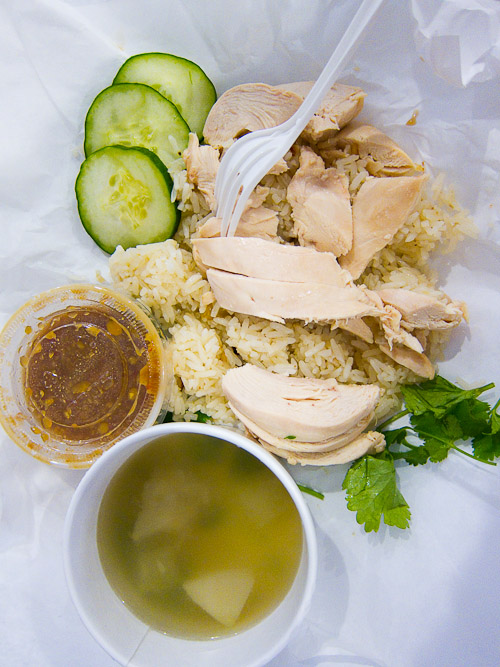 Most likely spurred on by similar success in LA, Portland's food stall scene has exploded in the last year. Stalls now allegedly number in the upper 500s and several so-called 'cart pods' can be found in various Portland neighbourhoods. But despite the buzz, not all carts are buzzing with customers. In fact, I'd say that relatively few appear to draw substantial numbers of diners. One of the lucky ones is Nong's Khao Man Gai:
Most likely spurred on by similar success in LA, Portland's food stall scene has exploded in the last year. Stalls now allegedly number in the upper 500s and several so-called 'cart pods' can be found in various Portland neighbourhoods. But despite the buzz, not all carts are buzzing with customers. In fact, I'd say that relatively few appear to draw substantial numbers of diners. One of the lucky ones is Nong's Khao Man Gai:
A native of Bangkok, Nong has been in Portland seven years and among other things, worked a stint at Pok Pok. In 2008 she decided to go into business for herself and less than two years later, her stall is one of the most popular in Portland. As illustrated above, the lines go around the block, and the amount of press this girl has received is pretty amazing:
Nong got in relatively early on the food cart trend and was able to score a prime downtown location. The food she's serving is also very good (I'll get to that in a minute). And I know that her success is also the result of good old-fashioned hard work. But if you ask me, a substantial portion of her success is a no-brainer: Unlike other carts that try to serve as many items as possible, Nong clung to the central tenet of good Thai street food: serve one tasty dish that you can do really well. Her dish is khao man kai (Hainanese chicken rice), and other than drinks, that's all you can get at her stall; no pad Thai, no vegetarian green curry, no dessert. And despite the fact that she's serving a single dish the vast majority of Americans have never even heard of, it's worked.
After having read about Nong's Khao Man Gai on websites and blogs for the last year, I was finally able to try a packet firsthand. Ducking into the lobby of a nearby building, I dug in and almost immediately my suspicions were confirmed: I reckon that Nong's khao man is as good -- or perhaps even better -- than that of your average Thai cart or restaurant. The rice was toothsome and slightly oily (as it should be, yet often isn't in Thailand) and had the slightest fragrance of galangal and ginger. The chicken was tender and tasty and the dish comes accompanied by an exceptionally rich and fragrant broth -- the delicious by-product of boiling those chickens. And perhaps most importantly, Nong's nam jim (dipping sauce) is pretty much spot on: tasty and moreish, sour, spicy and salty, but with a slight emphasis on the sweet.
Nong's Khao Man Gai Near cnr of SW 10th and SW Alder, Portland, Oregon 10am-2pm Mon-Fri & 11am-2pm Sat
View Thai Eats in a larger map
Plat du jour
 Diners at Portland restaurant Ping can expect fresh chanterelles, picked from the damp forests of Zig Zig, Oregon by the man himself:
Diners at Portland restaurant Ping can expect fresh chanterelles, picked from the damp forests of Zig Zig, Oregon by the man himself:
Am thinking they might go into yet another delicious laap het?
Podnah's
 Am home in Oregon for a couple weeks. I'm particularly excited about this visit as my buddy Hock also happens to be in-state, doing a temporary cheffing stint in Portland, and via his numerous visits to Thailand, I've become good friends with Andy, chef/owner of Portland restaurants Pok Pok, Whiskey Soda Lounge and Ping.
Am home in Oregon for a couple weeks. I'm particularly excited about this visit as my buddy Hock also happens to be in-state, doing a temporary cheffing stint in Portland, and via his numerous visits to Thailand, I've become good friends with Andy, chef/owner of Portland restaurants Pok Pok, Whiskey Soda Lounge and Ping.
One of my first meals in at home was at Podnah's, a Texas-style barbecue joint in NE Portland where Hock was doing his stage:
I grew up in the US, but haven't really been much of anywhere outside of the west coast, and my understanding of barbecue -- like that of many Americans -- began and ended at backyard-style grilled meats. Southern- and Texas-style barbecue is a different beast altogether, and involves smoking -- not grilling -- meats over a low temperature for several hours. It was this unique technique that Hock came to Oregon learn.
The kind folks at Podnah's put together a something of a sampler platter spanning their best barbecue (pictured at the top of this post): pork ribs, pulled pork and beef brisket. Apparently the pork ribs are a highlight, but I preferred the slight fattiness of the beef brisket. The pulled pork, served on slices of white bread, was also very good, and like all the meats, had a flavour and texture more in common with smoked than grilled food. The meats were accompanied by some tasty in-house made sauces, ranging from a smokey/spicy chili-based sauce to a tart vinegar-based one that I really enjoyed.
I particularly enjoyed the sides, which included a crunchy potato salad, baked beans, excellent savoury cornbread and possibly my favourite dish of the meal, something called Frito chili pie:
a spicy, bean-free chili served over Fritos corn chips and topped with cheese and thin slices of onion.
It was all a bit meat overload for me, but I really enjoyed the meal, particularly the communal serving style, which I thought had much in common with Asian-style dining.
Podnah's Pit Barbecue 1469 NE Prescott St, Portland, OR (503) 281-3700
Pressure cooking
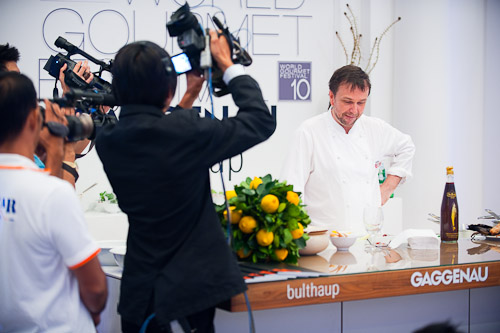 Boy did I miss a big fat plate of good ol' fashioned food controversy when I was away. As mentioned previously, Australian chef David Thompson has opened a branch of his Thai restaurant nahm here in Bangkok. Not surprisingly, when one considers how dearly the Thais regard their cuisine, the opening has inspired a generous serving of heated discussion here in Bangkok. Some of this was spurred on by this piece in the New York Times. The article makes for entertaining reading (sample quote: "'He is slapping the faces of Thai people!' Mr. Suthon said in an interview."), but is somewhat sensationalistic in tone and Thompson claims to have been quoted out of context. The controversy is also the topic of this BBC piece.
Boy did I miss a big fat plate of good ol' fashioned food controversy when I was away. As mentioned previously, Australian chef David Thompson has opened a branch of his Thai restaurant nahm here in Bangkok. Not surprisingly, when one considers how dearly the Thais regard their cuisine, the opening has inspired a generous serving of heated discussion here in Bangkok. Some of this was spurred on by this piece in the New York Times. The article makes for entertaining reading (sample quote: "'He is slapping the faces of Thai people!' Mr. Suthon said in an interview."), but is somewhat sensationalistic in tone and Thompson claims to have been quoted out of context. The controversy is also the topic of this BBC piece.
The local media also has its share of nahm/Thompson defenders and detractors. This rather clumsy restaurant review in The Nation seems to have been impressed with the restaurant, while this letter to the editor in the same paper is a dramatic and not entirely coherent damnation of nahm and its chef. The controversy has inspired a rather soul searching editorial in The Bangkok Post, "Which Way Thai Cuisine", as well as editorials in the Thai-language media, including the influential paper Matichon. But perhaps the epitome of the media attention was this hilarious spoof in Not The Nation: "Army Overthrows David Thompson In Cuisine Coup" (you know you're in the limelight when you're being spoofed).
People have the right to voice their opinions about cuisine and authenticity. But I find it disappointing how rather quite racist and xenophobic some of the Thai reaction to nahm has been; how would the Thais react to vaguely racist French criticism of a Thai landing a high-level cheffing job at Pierre Gagnaire? When it comes down to it, it really depends on the food, and I thought the most resounding sound bite about all this came from a Thai friend, who unlike many of the people writing or talking about the restaurant, has actually eaten there: "All I know is that if Nahm was about a quarter the price it is I'd be a regular. Authentic or not."
Lert Ros Alacarte
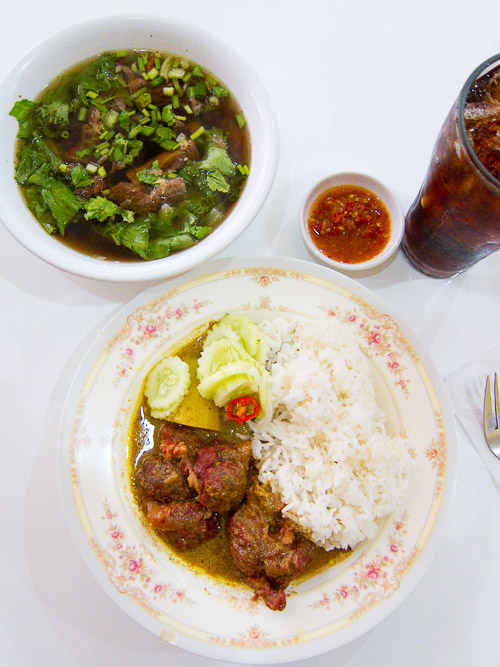 Inspired by a piece in the recent Food issue of Travel + Leisure Southeast Asia, I recently had lunch at a nearby, but previously un-visited restaurant, Lert Ros Alacarte.
Inspired by a piece in the recent Food issue of Travel + Leisure Southeast Asia, I recently had lunch at a nearby, but previously un-visited restaurant, Lert Ros Alacarte.
I ordered one of their set lunches, which included kaeng karii neua, a Chinese-style curry, a bowl of mild beef soup, and a glass of Coke (all for 125B, less than US$5). The beef in the curry was super tender and almost corned beef-like in texture and appearance, and the curry included a wedge of potato and was served with a spicy/sour dipping sauce. The soup, which turned out -- not surprisingly -- to be beef overload, was nonetheless good, and held a slightly sweet flavour, Chinese-style herbs and spices and tender tongue.
The food was solid, but I must admit that was almost more charmed by the old-school, diner-like atmosphere; think padded booths and lots of old furniture. The menu was equally old school and included dishes such as stewed beef tongue and fried rice with tamarind and shrimp. Am definitely looking forward to more meals at Lert Ros Alacarte.
As an aside, I'll be doing some travelling in some remote, predominately Internet-free areas for the next month and don't expect to be blogging. See you again in late October!
Lert Ros Alacarte 74-74/1 Soi 4, Th Silom, Bangkok 02 234 3754 10am-9pm Mon-Sat
View Thai Eats in a larger map













